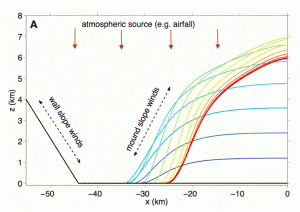The major reason for sending the Mars Science Laboratory rover Curiosity to Gale Crater is the five-kilometer (three-mile) high layered mound, dubbed Mt. Sharp, that looms at the crater’s center. The lowest layers have been altered by water and perhaps higher layers as well, possibly by lakes that have collected in the crater.

GROWTH BATTLED EROSION to make the mound in Gale Crater in the Kite team's computer simulation. Debris fell from the sky onto the growing mound, draping across layers already there. Then winds coming down the mound whittled at the new-deposited material as they met winds descending the crater's walls. The red line shows the final mound profile and its layering. (Image is taken from the online abstract.)
But where did the mound’s material come from — and what was its original extent? Did its sediments once fill all or most of Gale?
The mound’s origin was material that fell out of the air or was blown along the surface, says Edwin Kite (Caltech), who led a team of scientists in reconstructing the likely way the mound grew. Kite reported (PDF) on the group’s findings at the 44th Lunar and Planetary Science Conference in The Woodlands, Texas. (On the heels of the meeting, the same team published a paper in Geology that extends the argument in more detail.)
“Although mound is widely considered to be an erosional remnant of a once crater-filling unit,” the team notes that they found that layers in the mound showed bedding planes that dip down and outward. These suggest that the mound’s current form is close to its largest extent.
As the Kite group explains, “We propose that the mound’s structure, stratigraphy, and current shape can be explained by growth in place near the center of Gale Crater, mediated by feedback between winds and the crater’s topography.”
They add, “Our model shows how sediment can initially accrete near the crater center far from crater-wall downslope winds. Eventually the increasing relief of the resulting mound generates mound-flank slope-winds strong enough to erode the mound,” thus limiting its growth.
The group notes that the key observation was that most mound layers tilt outward. If the mound were a remnant of a thick deposit laid across the crater, it would have compacted in the center, tilting layers inward. The scientists conclude that the mound material didn’t come from lakebed sediments, for example, but eolian (wind-driven) ones.
As the mound grew, eventually it reached a size where downslope winds from the walls and the mound itself swept away the latest additions to the mound.
“Slope-wind erosion of indurated or lithified eolian deposits cannot explain our data,” the team says, “unless the topographic depression surrounding the mound existed during mound growth.” This requirement links the mound layer orientations, slope winds, and the mound’s size.
The team suggests its findings indicate “The mound grew with its modern shape, and that the processes sculpting the modern mound may have molded the growing mound.” They add that Curiosity can start testing this model as soon as it reaches the foot of Mt. Sharp.








